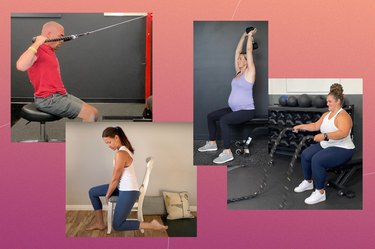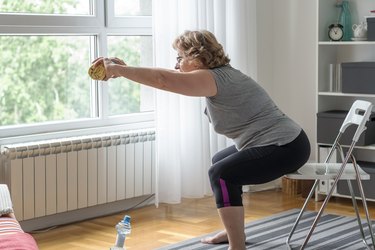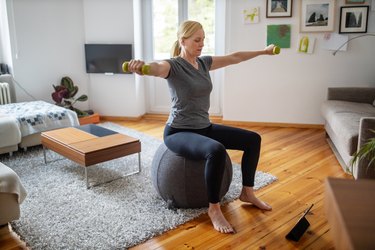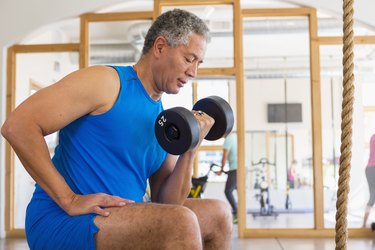
Seated exercises are a tried-and-true method for building strength. And the best part is, seated exercises are great for every body and anybody.
The value of seated exercises is they add stability, which enables you to focus on isolated movement patterns or joint-specific work without worrying about balance, says James Norris, an adaptive athlete with cerebral palsy and founder of Handi Capable Fitness.
Video of the Day
For example, doing biceps curls in a seated position takes your lower body out of the equation, allowing you to really max out your biceps gain.
To prove just how easy and convenient it is to get a great workout while sitting down, we tapped four trainers to share what makes seated exercises so great for all fitness and mobility levels and break down their favorite moves.
Tip
As with any exercise, the key to seeing safe, effective results from a seated exercise is to maintain solid posture.
“Think about stacking your ribs directly over your hips and sending the crown of your head toward the ceiling,” says Lauren Pak, CPT, certified personal trainer and co-founder of Achieve Fitness Online.
Stacking your body in this way will place your core in an ideal position to support your upper body, which helps reduce or prevent any lower back discomfort while seated, she explains.
Seated Upper-Body Exercises
These moves target your shoulders, biceps, triceps, chest and back for strength, mobility and muscle gain. To do them, you'll need a resistance band, pair of dumbbells and a yoga block (or other small, light object).
1. Seated Dumbbell Front Raise
- Sit tall on a chair or bench and hold a dumbbell in each hand against the tops of your thighs. Brace your core.
- Keeping your arms straight, raise the weights in front of your torso until they reach shoulder height, palms facing the floor.
- Pause briefly before lowering the weights with control. Repeat.
2. Seated Dumbbell Lateral Raise
- Sit tall on a chair and hold a dumbbell in each hand. Let the weights hang at arm’s length by your sides, palms facing in.
- Tighten your core. Keeping your arms straight, raise the weights out to your sides until they reach shoulder height.
- Pause briefly before lowering the weights with control. Repeat.
3. Seated Banded Face Pull
- Anchor a resistance band to a sturdy fixture overhead, like a pole or door anchor. Position your bench or chair far enough from the anchor point so you feel tension in the band while seated with both arms extended, slightly above shoulder height. (Alternatively, you could use a cable machine as shown.)
- Sit tall, and hold one end in each hand (with an overhand grip).
- Squeeze your shoulder blades together and pull your elbows back to
- Pause briefly before extending your arms in front of you again. Repeat.
The resistance band/cable face pull fortifies your scapular retractors and external shoulder rotators, Norris says.
4. Seated Horizontal Scapular Rotation
- Sit tall with both feet flat on the floor. Hold a yoga block (or other small, light object) in front of your chest with your arms fully extended.
- Keeping your torso in place, reach the yoga block as far forward as you can. You’ll feel a gentle stretch in the front of your shoulders.
- While holding that reach, shrug your shoulders up toward your ears.
- From that shrug, pull your shoulders blades back and together.
- While holding that squeeze, drive your shoulders down, as far away from your ears as you can.
- Finally, holding that downward push, reach your arms forward as far as you can to begin the next round.
This move gets your shoulders moving in a full circle, helping mobilize your shoulder blades and all of the attached muscles, says Kate Galliett, CPT, certified corrective exercise specialist and founder of Fit For Real Life. “It serves as a good strengthener for the shoulder muscles, too,” she adds.
5. Seated Banded Alternating Chest Press
- Sit tall on a chair. Wrap a resistance band around your back so you’re holding one end in each hand in front of your chest, elbows bent. You should feel tension in the band. (You may need to use a TheraBand or anchor the band to a sturdy object behind you.)
- Press both arms forward so they’re parallel to the floor.
- Keeping one arm extended, bend the other elbow to bring your hand toward your armpit as though you were doing a push-up.
- Press that arm forward and repeat the motion with the other arm.
The alternating chest press targets the chest, shoulder and triceps, while sneaking in a bit of oblique work, Galliett says.
6. Seated Banded Row
- Anchor a resistance band so it’s at chest height while you’re in a seated position. Grip one end in each hand, palms facing in. (You can also use a cable machine as shown.)
- Position your chair far enough from the anchor point so you feel tension in the band while your arms are extended in front of your chest.
- Sit tall, brace your core and squeeze your shoulders back and together. Then pull your elbows to either side of your ribcage, stopping when they go just past your back.
- Pause briefly before extending your hands in front of you. Repeat.
Rows of any flavor will help you build a strong back and improve your posture, says Morit Summers, CPT, certified personal trainer and founder of Form Fitness.
7. Seated Shoulder Press
- Sit tall on a chair and hold a dumbbell in each hand.
- Lift your elbows out to the side to create a goal post position with your arms, dumbbells on either side of your head.
- Tighten your core. Press the dumbbells overhead until your arms are fully extended, keeping your biceps by your ears.
- Pause briefly before lowering the weights with control. Repeat.
This move hits the front portion of your shoulders as well as your triceps.
8. Seated Battle Rope
- Sit tall at the edge of a chair or bench and grip one end of a battle rope in each hand. Your elbows should be bent 90 degrees at your sides.
- Tighten your abdominals and lift the ropes high before slamming them into the floor. Immediately go into your next rep and continue for time or reps. Try not to pause at any point so your motions stay fluid.
- Keep your chest up even as you fatigue; don’t slump.
Seated battle ropes build muscular endurance in your upper body, while also getting your heart rate up, Summers says.
9. Seated Biceps Curl
- Sit tall on a chair or bench and hold a dumbbell in each hand. Let the weights hang at arm’s length by your sides, palms facing forward.
- Keeping your arms tight against your sides, bend your elbows to curl the dumbbells up toward your shoulders, squeezing your biceps at the top.
- Pause briefly before lowering the weights. Repeat.
As the name implies, this exercise works your biceps — the two-headed muscles in the front of your arms, Pak says.
10. Seated Triceps Extension
- Sit in a chair or bench with your feet flat on the ground. Grip a dumbbell with two hands just below your head so your thumbs cross one another.
- Use both hands to lift the dumbbell overhead and position it behind your head so your thumbs graze the back of your neck. Your elbows will be bent and hugging the sides of your head.
- Sit up straight to open your chest. Keeping your elbows in place, press the dumbbell overhead until your arms are fully extended and you feel a slight squeeze in your triceps.
- Pause briefly before returning the weight behind your head. Repeat.
“This exercise works the triceps and shoulders and not only offers aesthetic benefits but can contribute to stronger push-ups and bench presses,” Pak says.
Seated Lower-Body Exercises
You don't have to stand up to strengthen your hip flexors, glutes, hamstrings and calves. To do these seated leg exercise, you'll need a yoga block or pillow and a pair of dumbbells or weight plates.
1. Seated Hip Flexion Hold
- Sit tall on a chair and place a small pillow or yoga block against the top of your chest on one side of your torso.
- Without bending forward, lift one knee to press the top of your thigh into the pillow or yoga block. Keep your other foot flat on the floor. Continue pressing your thigh into the pillow or yoga block to hold it in place.
- Repeat on the opposite side.
2. Seated Hip Rotation
- Sit off to the side on a chair so one leg can hang over the edge. Place the other foot flat on the floor. Hold onto your chair for support.
- Begin the movement by dropping your working leg so the knee points toward the floor. Then, lift that foot off the ground as if you’re pulling your heel toward your glutes. Pull your thigh backward as far as you can without arching your back or tipping your pelvis forward.
- Once your thigh goes as far back as possible, hold it there while you rotate your knee up and out and begin to lift it toward the ceiling. Lift your knee as high as you can without arching your back or tipping to one side.
- Once you’ve lifted your knee as high as you can, pull it toward the midline of your body until it comes back around in front of you.
- Lower your leg back down to the starting position and repeat. Do all reps on one leg before moving to the other side of your chair and doing the exercise with your other leg.
This move strengthens the glutes and hamstrings, while injecting healthy movement into the hip capsule that houses the top of your thigh bone (femur).
3. Seated Weighted Calf Raise
- Sit tall at the edge of a chair or bench with your forefeet on top of a weight plate with your heels hanging (if you don't have a plate, place your feet flat on the ground). Place a weight plate on top of your thighs or hold a dumbbell on top of each knee.
- Slowly lift your heels off the ground until you feel a squeeze in your calf muscles.
- Pause briefly before lowering. Repeat.
“If you do any running or jumping in your life, it’s really important to have strong calf muscles in order to support those endeavors,” Pak says. The seated calf raise has got you covered.
Seated Core Exercises
Fire up your core and challenge your stability with these core exercises for all strength levels. For them, you'll need a low box or step and a long looped resistance band.
1. Seated Rotating Reach
- Sit in a chair and center yourself on your pelvis so you can feel your sitz bones beneath you. Place one foot flat on the floor and the other on low box or step so your leg is extended straight in front of you.
- Flex the foot so your toes point toward the ceiling. Notice what the front of your ribcage is doing: if it’s pulled forward or up, allow it to drop down.
- Raise the arm opposite your lifted leg so it’s fully extended with the fingers pointed forward.
- Inhale through your nose, allowing your ribcage to expand. Then, rotate your torso to reach for the toes of your extended leg. As you reach, exhale firmly through your mouth as though you were blowing up a balloon.
- Hold the rotating reach as you inhale quietly again. Then, exhale and try to rotate and reach even farther.
- As you reach, check to make sure you’re not rounding your back or bending at the waist.
- Reverse the movement and repeat. Do all your reps on one side before switching to the other.
As you reach for your extended leg, think about rotating your body around your spine to allow you to reach as far as possible, Galliett says. To make this move more challenging, you can hold the extended leg in the air.
2. Seated Banded Pallof Press
- Anchor a resistance band so it’s at chest height while you’re in a seated position.You can also use a cable machine (as shown).
- Facing the anchor sideways, grip the ends against your chest with both hands.
- Position your chair far enough from the anchor point so you feel tension in the band.
- Sit tall, brace your core and press your hands in front of your body until your arms are fully extended. Resist rotating at the torso and hips.
- Bring your hands back to your chest and repeat. Complete all reps on one side before turning around 180 degrees and repeating on the other side.
This move builds core stability by strengthening the muscles that surround your spine, Summers says. To make the move harder, move farther away from the anchor point or use a thicker band.
Who Can Benefit From Seated Exercises?
Anyone. Both seasoned powerlifters and gym newbies can benefit from seated exercises.
However, for people who standing exercises are not accessible, seated ones are vital. This includes anyone with musculoskeletal pain or low levels of leg function, mobility or balance.
For example, seated workouts are an ideal training method for those with cerebral palsy (a group of neurological disorders that affect motor control and balance), Norris says. They're also a safe option for older adults with balance issues, anyone with chronic fatigue syndrome, those who use wheelchairs and anyone who feels more comfortable in a seated position than a standing one.
"Pregnant individuals can also benefit from seated exercises, especially if they're experiencing hip and/or pelvic pain," Pak says. Taking a seat can relieve some of the stress your growing abdomen places on the joints and muscles in your lower back and pelvic area.


